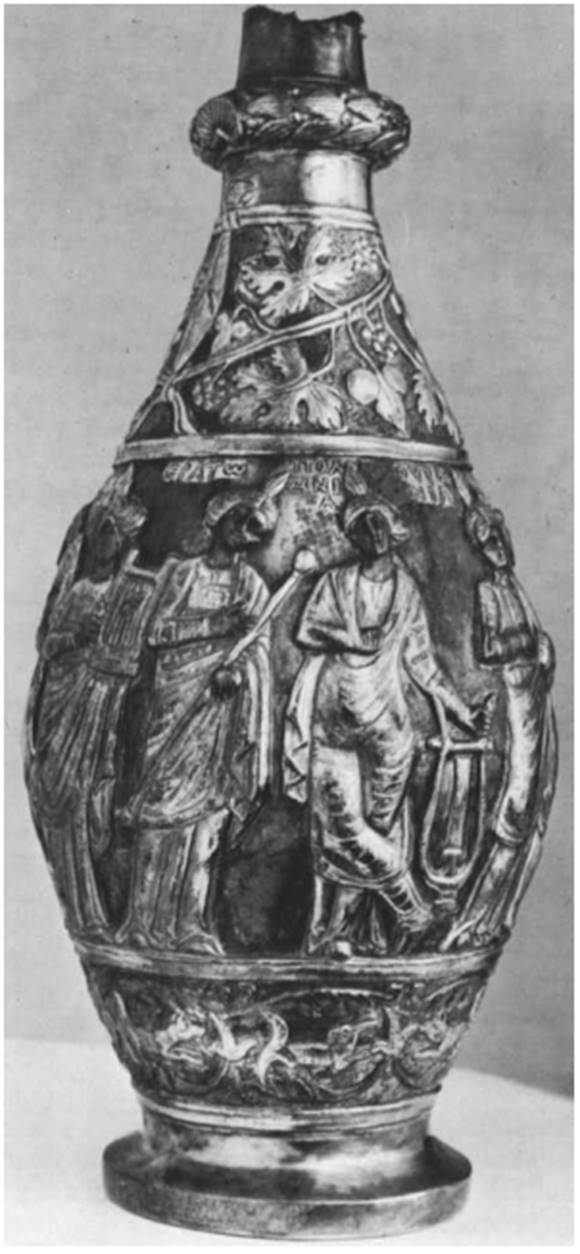Pitcher with the nine muses. Constantinople, about 400. Silver with gilding
The mouth of the pitcher is broken, and a handle that extended from shoulder to mouth is missing. There are three bands of relief decoration below a laurel wreath that gives the impression of having been slipped over the neck. The top band consists of two vine cuttings; in the bottom band is an acanthus frieze inhabited by pairs of animals. In the main zone is a procession of the nine muses, each identified by a Greek inscription. Coloristic effects are achieved through the gilding of much of the relief decoration and the inscriptions; the faces and hands of the muses are reserved in silver for contrast.

The muses are depicted frontally, moving slightly to the right. The procession begins, or ends, at the left with Clio, muse of history, writing in a tablet; like her sisters she wears a headdress of feathers, symbolizing the muses' victory in a singing contest with the Sirens. There follow Euterpe (rhythmic music, elegy), holding the long flutes and wearing a traditional high-girt costume; Thalia (comedy) with a comic mask; Melpomene (tragedy) with both a tragic mask and the high-soled shoes (kothurnoi) worn on the stage by tragic actors; and Terpsichore (lyric poetry), playing the lyre. The next two muses were evidently mislabeled by the artist; first a figure holding a long scepter, identified as Erato (muse of love poetry and ceremonial verse), then a figure holding a lyre, called Polyhymnia (pantomime). But the attribute of Erato is properly the lyre or kithara, and Polyhymnia holds a scepter in the Monnus mosaic at Trier (Parlasca, 1959, pi. 43, fig. 1). The artist has inadvertently exchanged the names of these two muses. There follow Urania (astronomy) with the globe of the heavens and Calliope (epic poetry) with the scroll.
In the late Hellenistic period the muses began to play a role in funerary beliefs, as can be seen in their appearance on a large group of sarcophagi (cf. no. 240). Not only did they keep alive the memory of poets and sages, but it was also believed that men and women of intellectual or cultural achievement might join their company after death.
This pitcher was found in a tomb and may well have had some such meaning for the man whom it accompanied. Unfortunately, the tomb was excavated by local farmers, and little is known of its circumstances. It was found in 1918—1919 at Bolshoi Kamenets in the Dnieper basin. On the underside of the pitcher is a silver stamp, which indicates that it was made in Constantinople in the late fourth or early fifth century (Dodd, 1961, pp. 4-5); a vase of similar shape but with Christian iconography was found in the Traprain Law hoard in Scotland (no. 389). Although the figures have classical models (perhaps in sarcophagi), their frontality, heavy proportions, and oddly tilted heads indicate a date in the post-Constantinian period. The decorative friezes, a characteristic of early Byzantine silver, are particularly fine. Bibliography: Matzulevich, 1934, pp. 119-125; Dodd, 1961, no. 84; Bank, 1966, p. 333, pis. 2-5; Strong, 1966, p. 191; Pisarskaya, 1970, pis. I-IХ.
Date added: 2025-08-31; views: 75;
